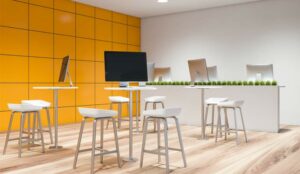Hybrid work requires adaptable office workspaces equipped with the right tech for varying activity-based work styles.
As we begin a gradual return to the office, we know that 86% of companies are reported to be revising their real-estate strategies.
To make sure that the lessons of the pandemic are learned, companies need to repurpose office space in order to sustain organizational performance and drive culture in hybrid working arrangements.
As office spaces are no longer considered the primary place where work is done, and teams everywhere reap the benefits of working from home, it is important to ask what uses people will return to the office for.
IT decision makers need to work with infrastructure teams to facilitate these new ways of working and maximize the hybrid working office experience.
The Future of the Hybrid Workspace
After many months of buildings standing empty, people are now returning to the office. For leaders, the choices are complex, with varying parameters to consider.
With much of the knowledge work we used to do from the office now possible from home, the office will shift primarily to a space for collaboration and culture. The foundations of teamwork and trust that lead to high-performing organizations will be fostered in these spaces.
With this type of hybrid setup and purpose in mind, leaders need to balance collaboration space optimization with flexible activity-based work areas. For IT decision makers, this means investing in immersive collaboration technology that can adapt to a range of spaces and types of work.
This needs to be seamless and safe for those in the office, while ensuring inclusivity for remote participants, for equal and productive collaboration. In the U.S., 72% of executives are planning new investment in tools for virtual collaboration to support hybrid working.
Creating Flexible Collaboration Spaces
Future offices will need to be flexible, where teams can come together to work in ‘pods’ or ‘neighborhoods’ that can be customized to the task at hand.
What employees need from a workspace will change over time and the technology that enables them to concentrate and collaborate will play a large part in enabling spaces to remain flexible and adaptable.
People are more creative when they’re together, but traditional open-plan offices do not facilitate the type of interactions that drive productivity and creativity.
Instead, unstructured collaboration spaces that are customized by technology will need to be a central consideration for any office space. These spaces will facilitate trust from social interactions, and creativity through collaboration.
To manage this transition, organizations need to consider the following:
- Recodifying the Office
Leaders need to define the purposes of an office as a resource. If we return purely for all-day meetings, or use the office as a space to get work done on a screen, we’ll lose the human elements we’ve missed during remote working. Leaders need to make clear that the office is a space where collaboration and connection with colleagues can take place in a variety of formats. - Creating Flexible Collaboration Spaces
Collaboration spaces need to be able to adapt to meetings, brainstorming, team hot desking clusters, or any collaboration from formal to informal. Acoustic design to manage noise, as well as building blocks to convert spaces with partitions and mobile furniture clusters will help facilitate collaboration, from impromptu networking or connection to pre-arranged meetings. - Deploying Intelligent Technology to Connect Teams Across Spaces
Technology will be needed in all workspaces to connect remote participants and allow for inclusive collaboration across locations, regardless of where people are joining meetings from. Collaboration technology that includes all participants, enables social distancing for in-office employees, and seamlessly brings people into the same space will be a baseline for successful hybrid work. - Reevaluating With Data
For every organization, this will be a process that requires regular iterations, both reacting to external guidelines, as well as figuring out what works for employees. Having data available to make these decisions on your office spaces will be crucial. Collaboration technology that offers usage data on the spaces in which meetings are taking place can help inform the adaptations you make to optimize your office space for these changes.
Considering Collaboration Technology in Activity-Based Workspaces
As leaders and IT decision makers explore long-term investments for the future of the hybrid office space, they must consider the broad range of activities for which their increasingly diverse workforce will use the office, and how they can enable all of them to occur simultaneously in the office.
As 66% of leaders consider redesigning office space for hybrid work, ITDMs should keep in mind the words of Julian Treasure, expert on sound and work environment:
“If you’re running a brand or an organization, you need to ask yourself: What sound are we making and how are we influencing people’s behavior? There is absolutely nothing stopping us from designing with our ears as well as our eyes.”
Author: Guest Author
Published On: 1st Jun 2021
Read more about - Guest Blogs, Jabra




































